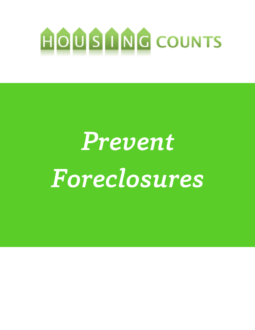Prevent Foreclosures and Help Affected Owners
While most communities have programs to help renters become homeowners many communities do not focus enough on keeping existing homeowners in their homes. Foreclosure prevention programs help homeowners who are struggling to make mortgage payments or have defaulted on their mortgage and are in danger of foreclosure. Foreclosure prevention programs work by providing people with basic maintenance assistance, counseling and access to attractively priced refinancing options. The goal is to keep people in their homes at an affordable cost while preserving home values and stability in the surrounding community.
Why should communities get involved in foreclosure prevention?
Communities across the country are facing rising foreclosures due to a combination factors. There are the usual problems of job loss and medical emergencies but this is being exacerbated by deteriorating economic conditions.
The number of mortgage foreclosures in Minnesota and throughout the country dramatically increased during the economic crisis beginning in 2006-07. Minnesota experienced about 6,500 foreclosures in 2005. In 2008, that number increased to nearly 27,000 foreclosures. The number of foreclosures decline to 11,834 in Minnesota in 2013. This marked the third consecutive year of double-digit percentage declines in foreclosure, with 2013 coming in at less than half the total number of statewide foreclosures than the last “high water mark” total in 2010. Perhaps even more notable: the number of foreclosures in 2013 is just below the total number in 2006, the year generally regarded as the first year of the foreclosure crisis as indicated in the 2013 Annual Foreclosure Report.
Even though we have seen great decline in foreclosure numbers, this situation still affects many home borrowers. Foreclosures affect more than just individual borrowers. Foreclosures continue to deplete existing resources and displaces thousands of families and children. The vacant and boarded structures left behind, devastate neighborhoods and surrounding property values and frustrate community reinvestment and recovery. Government efforts can help both individual borrowers and the community overall by:
- helping people stay in their homes and retain their equity,
- preventing widespread losses in low- and moderate-income homeownership,
- stabilizing communities,
- safeguarding local property tax rolls, and
- protecting nearby homeowners from equity loss.
Assistance is available to homeowners who may be facing foreclosure or are having difficulty making mortgage payments due to an economic crisis. The Minnesota Homeownership Center has access to the Homeownership Advisors Network that provides free resources to help reduce the likelihood of foreclosure.
What policies can help prevent and respond to foreclosures?
Foreclosure prevention policies can target assistance directly to households in need, or can focus at the community level. On the community level programs can work on modifying the regulatory environment to reduce both foreclosures and their impact on neighborhoods. The policies that can help prevent and respond to foreclosures vary depending on how deep into financial trouble people are.
Case study: Woodbury Foreclosure Purchase Program
The objective of the Woodbury Foreclosure Purchase Program is to encourage the purchase of foreclosed properties in the City of Woodbury by providing financing to low- and moderate-income purchasers. Low-interest, deferred loans of up to $25,000 are available to qualified families who earn no more than 115 percent of area median income, capped at $90,000 per household. The purchase price of the affected homes may not exceed $256,500. Single-family detached houses, town homes or condo units are eligible for this program. The nature of the financing will help keep a household’s housing costs affordable over the long term due to the principal deferral, the low interest rate and the fact that many lenders view the Woodbury funds as equity allowing borrowers to access conventional financing thereby avoiding costly PMI charges or FHA premiums.
